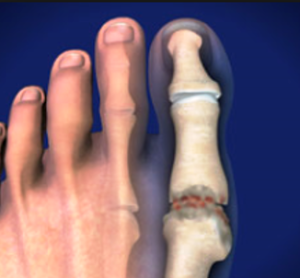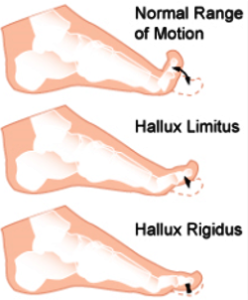Hallux Limitus
Hallux Limitus/Rigidus (Big toe stiffness)
Hallux rigidus is a disorder of the joint located at the base of the big toe. It  causes pain and stiffness in the joint, and with time it gets increasingly harder to bend the toe.
causes pain and stiffness in the joint, and with time it gets increasingly harder to bend the toe.
In its earlier stage, when motion of the big toe is only somewhat limited, the condition is called “hallux limitus.” But as the problem advances, the toe’s range of motion gradually decreases until it potentially reaches the end stage of “rigidus,” in which the big toe becomes stiff, or what is sometimes called a “frozen joint.” ‘Hallux” refers to the big toe, while “rigidus” indicates that the toe is rigid and cannot move. Hallux rigidus is actually a form of degenerative arthritis.
This disorder can be very troubling and even disabling as we use the big toe whenever we walk, stoop down, climb up, or even stand. Many patients confuse hallux rigidus with a bunion, which affects the same joint, but they are very different conditions requiring different treatment.
Causes
In some people, hallux rigidus runs in the family and is a result of inheriting a foot type that is prone to developing this condition. In other cases, it is associated with overuse and trauma. Some other causes of hallux limitus include;
- Foot type – excessive flat feet (pronation) or high arch feet (supinated).

- Trauma – stubbing your toe.
- Inflammatory diseases – gout or rheumatoid arthritis.
- Repetitive stress on the big toe joint – activities that require a lot of squatting.
- Length of first metatarsal bone – excessively long or short metatarsal.
Symptoms
Early signs and symptoms of hallux limitus include;
- Pain and stiffness in the big toe during use (walking, standing, bending).
- Callus formation underneath or on the side of the big toe.
- Difficulty performing certain activities (running, squatting).
- Swelling and inflammation around the joint.
- Difficulty wearing shoes.
- Dull pain in the knee, hip or lower back due to a change in gait (the way you walk).
Treatment
The sooner this condition is diagnosed, the easier it is to treat with conservative methods. Therefore, the best time to see a podiatrist is when you first notice symptoms. If you wait until bone spurs develop, your condition is likely to be more difficult to manage.
At Sydney Foot Clinic, the podiatrist in diagnosing hallux rigidus will examine your feet and move the toe to determine its range of motion. Medical imaging such as X-rays will most often be prescribed to help determine how much arthritis is present as well as to evaluate any bone spurs or other abnormalities that may have formed.
At Sydney Foot Clinic the following treatments are offered to treat Hallux Limitus;
- Shoe modifications – Shoes with a large toe box put less pressure on your toe. Stiff or rocker-bottom soles may also be recommended.
- Custom Orthotic therapy – prescription of a custom orthotic placed in your shoe will address any biomechanical factors (flat feet or high arch feet) reducing the stress and pressure at the big toe joint. Orthotics can also be used to splint/brace the big toe if Hallux Rigidus is present.
- Injection therapy – Prolotherapy can help reduce symptoms and offer relief.
- Medications – non sterioidal anti-inflammatory medications (NSAIDs) and Ice- help reduce the pain and inflammation.
In some instances and progressed deformities conservative treatment may fail and surgery may be required to reduce pain and relieve symptoms.
